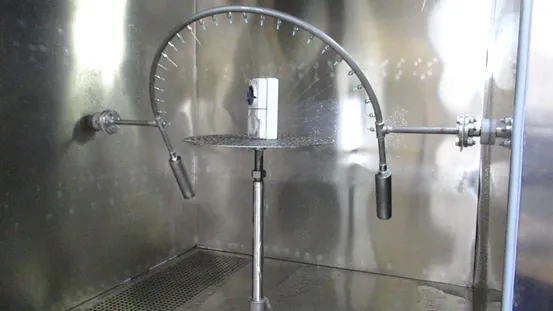DIN 40050 9 IP Code Testing for Road Vehicles in Germany
The DIN 40050 series of standards is a set of German technical specifications that provide guidance on the protection levels against foreign objects and water ingress. Specifically, IP (Ingress Protection) Code Testing for Road Vehicles in Germany ensures compliance with DIN 40050-9, which specifies the testing procedure for determining the IP rating of road vehicles.
The primary purpose of this service is to ensure that road vehicle components and systems are protected against dust, dirt, water, and other environmental factors. The test results provide a clear indication of the vehicle's ability to withstand harsh conditions encountered in real-world driving environments. This level of protection is crucial for maintaining the integrity and performance of critical automotive parts, especially those exposed to the elements.
The testing process involves exposing the vehicle or its components to various levels of water ingress under controlled environmental conditions. The test setup includes a series of chambers designed to simulate different types of water exposure, such as rain, splashing, and immersion. Additionally, the tests also assess resistance against dust particles, which can accumulate in areas like door handles, window seals, and other openings.
Compliance with DIN 40050-9 is mandatory for manufacturers who wish to sell their vehicles within Germany or meet the requirements of European Union directives on vehicle safety. Non-compliance could result in delays in market entry or even product recalls, leading to significant financial losses.
The testing procedure typically follows a structured approach:
- Preparation of the test specimen (the road vehicle).
- Setting up the test chamber with the appropriate water and dust conditions.
- Exposing the vehicle or components to the specified environmental factors for the required duration.
- Evaluating the integrity and performance of the vehicle after exposure.
The testing process is not only about compliance but also about enhancing product quality. By adhering to these standards, manufacturers can ensure that their vehicles are robust enough to withstand various environmental challenges, thereby increasing customer satisfaction and brand reputation.
Our laboratory utilizes advanced instrumentation and equipment to conduct these tests accurately and efficiently. We employ industry-standard test methods such as those outlined in DIN 40050-9, ensuring consistent results across multiple samples and batches.
Frequently Asked Questions
Scope and Methodology
| Test Parameter | Conditions |
|---|---|
| Type of Water Exposure | Rain, Splashing, Immersion |
| Dust Particle Size | Standardized particles within the IP rating range |
| Environmental Conditions | Temperature and humidity controlled to specific levels |
| Test Duration | Varies based on the IP code level being tested |
The scope of our testing includes a comprehensive evaluation of the vehicle's ability to withstand water ingress, dust exposure, and other environmental factors. The methodology is designed to replicate real-world driving conditions in a controlled laboratory environment.
Why Choose This Test
- Mandated by German law for vehicles sold within Germany.
- Ensures compliance with European Union directives on vehicle safety.
- Reduces the risk of product recalls and market entry delays.
- Enhances brand reputation through demonstrated commitment to quality.
The test is crucial for ensuring that road vehicles are robust enough to protect critical components under various driving environments. Compliance with DIN 40050-9 demonstrates a manufacturer's dedication to safety and performance standards.
Use Cases and Application Examples
- Vehicles operating in harsh weather conditions, such as rain or snow.
- Automobiles used in industrial settings where dust and dirt are prevalent.
- Road vehicles designed for off-road use or extreme environments.
The test is particularly relevant for manufacturers who operate in Germany or plan to expand into the German market. It ensures that all vehicle components meet the necessary standards for safety and performance, thereby enhancing customer satisfaction and brand reputation.





